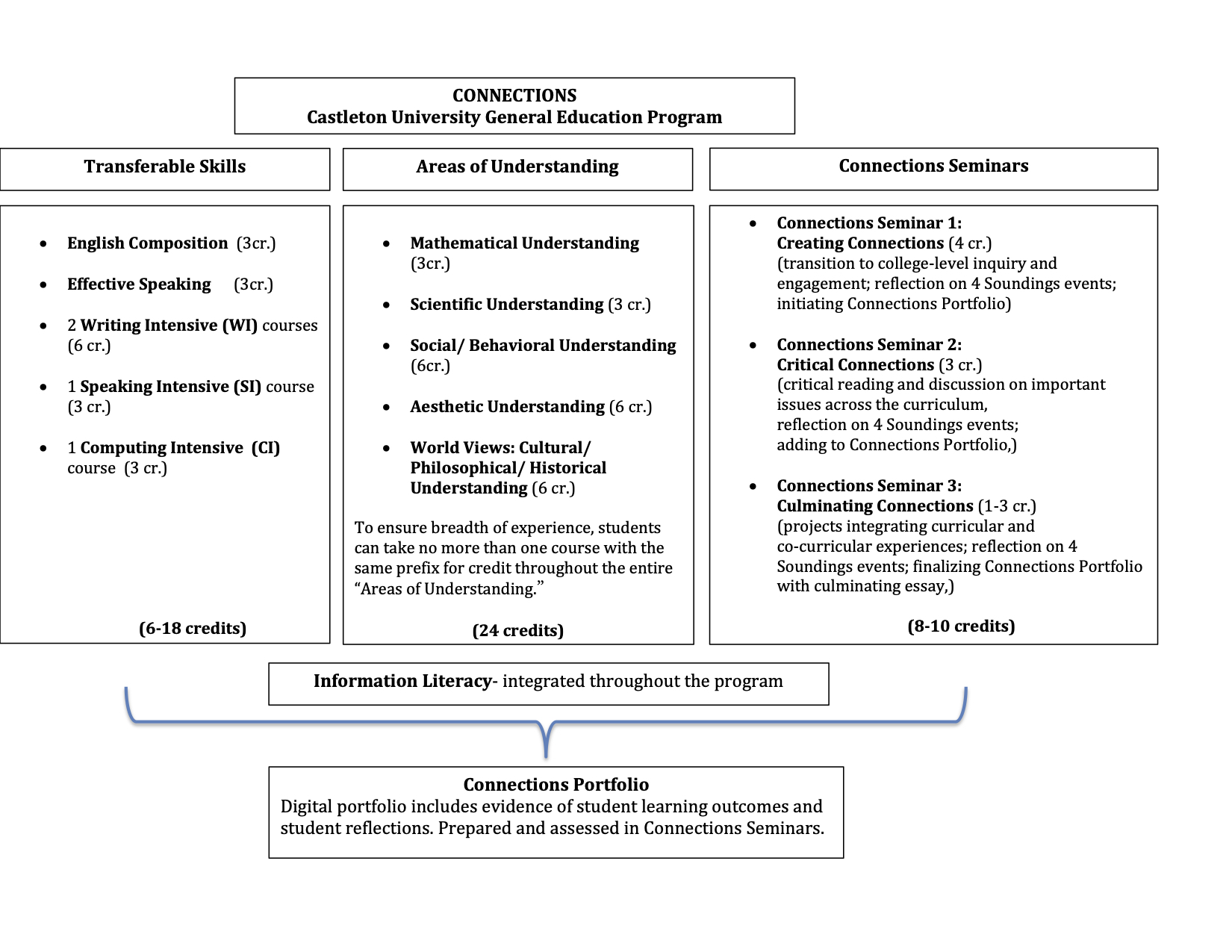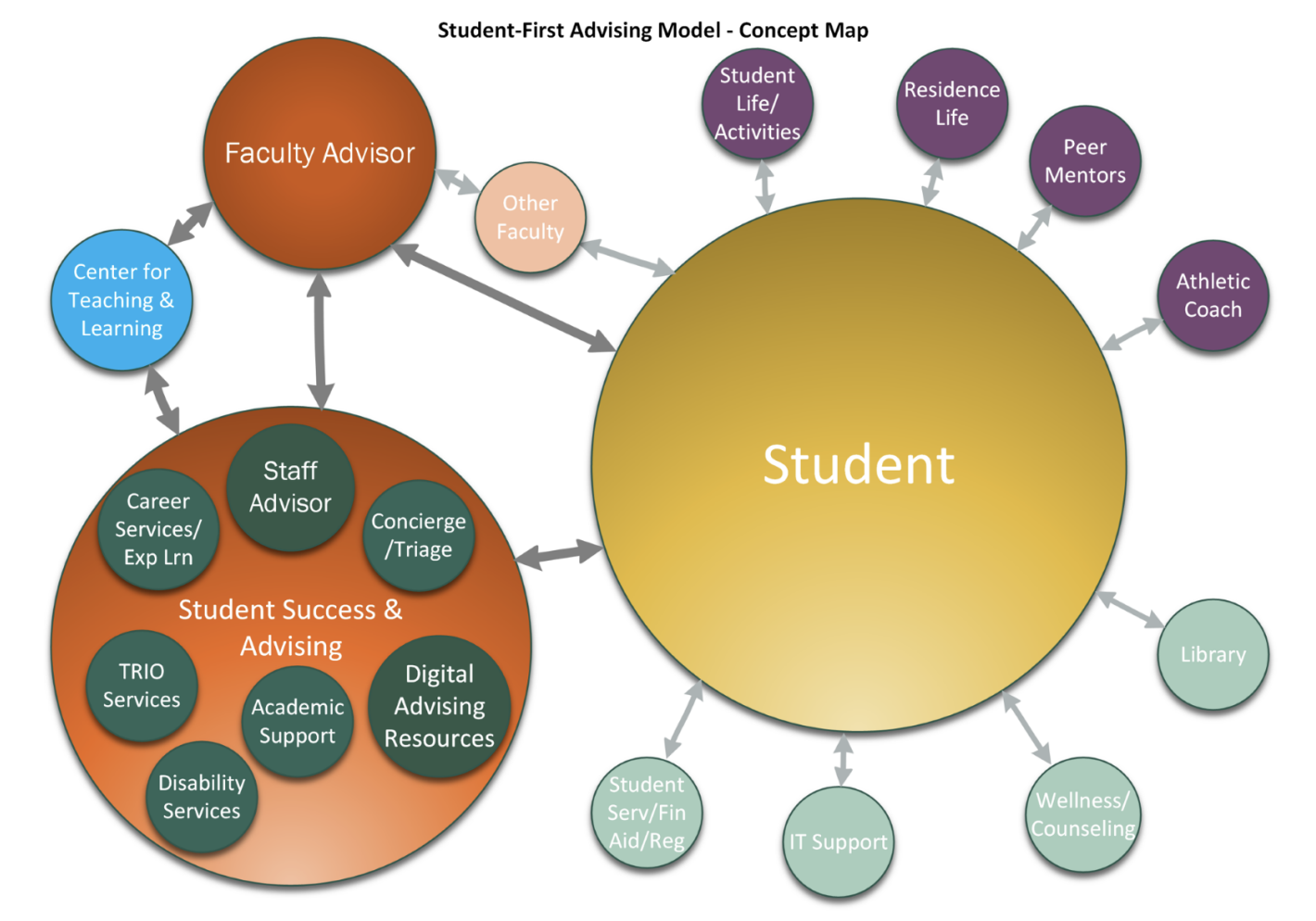Would it surprise you to learn that Castleton’s Connections Program is a model for other campuses? Prior to the reform of the program last year, there were some aspects of the program that were well-regarded. Faculty from other campuses have come to Castleton to learn about Soundings, for example, and the design of the Frames of Reference, now Areas of Understanding, put Castleton well on its way to an ideal program as the Association of American Colleges and Universities described it. But we were glad to hear that general education expert and consultant Paul Hanstedt (who has consulted with CU and the VSC), shares our new Connections Program design with other institutions as a model for them to emulate!
The new title of the program –“The Connections Program”—emphasizes that the program is not just a set of requirements; instead it is designed to be a coherent academic program with staged, developmentally appropriate steps. But this is also the largest and most complicated academic program at CU, or in the VSC, and it is taken by every student. So the central ambition is that the program will provide fertile ground for the students to make all sorts of connections between its various learning opportunities and find what is really valuable in the program for themselves. The courses offer the raw materials, let’s say, for these connections. Crucially, though, the program also provides students with the occasion and the instruction on how to make these connections themselves.
The parts of the program can be organized into three broad categories:

Transferable Skills, such as writing and speaking, are skills that students need to learn in order to be successful in college and beyond. The courses in this category are pretty much the same as they were before the program redesign. One big change, though, is that the program will meet the four VSC graduation standards in some new ways. WI and SI stay the same, but the students will meet the Quantitative Reasoning standard through a new Mathematics requirement and the Information Literacy standards through their work in the Connections Portfolio (see below).
The Frames of Reference are now the Areas of Understanding. They help students to gain knowledge on a wide variety of fields and to learn how those fields make that knowledge. In practical terms, though, the included courses remain largely the same. The “Science and Math Frame” has split into Natural Science and Mathematics to assure that students take a course in each. The faculty have undergone an initial process of designating courses each in a single Area of Understanding. A new change is that a student may only count one course in each prefix (e. g. ENG or MAT) for credit in the Areas.
The Connections Seminars are a new addition, adding a crucial integrative element to the program. Students take one seminar in each of their first three years. One of the central purposes of these new seminars is to guide student reflection on what they are learning. These courses are designed to help students to make those important connections between their courses in the program, their major studies, and college activities.
Connections Seminar 1 replaces FYS. Though some new approaches will assure a more consistent student experience, this course is largely the same as the previous FYS. It provides students with a transition to college and some education in what it takes to be an effective student.
Connections Seminar 2 replaces Touchstones of Western Literature. In this course, students read thought-provoking works drawn from across the Areas of Understanding. The idea is that with a full year or more of Gen Ed courses under their belts, students will be ready to start thinking seriously about how these courses and their many college experiences can really speak to one another.
Connections Seminar 3 is a new course. Students can take this course by taking a special 3-credit CNX course, they can take a designated major course, or they can fulfill this course with a 1-credit seminar. In this course, students reflect on their learning throughout the program and produce a final portfolio.
Note: Soundings has been integrated into these seminars and is no longer a standalone course (students are automatically enrolled in it when they take each seminar). Students must now attend four events during that semester, and the expectation is that they will have rich opportunities to talk about the events in their Connections seminars. Since it is possible to pass the seminar but not meet the basic Soundings requirements, Soundings will continue to be offered as a standalone course for those who need it.
One final addition is the new Connections Portfolio. This is an e-portfolio that students will assemble throughout the program, and completing it is now a graduation requirement. The portfolio is introduced to students in Connections Seminar 1 and then they compile and curate the portfolio in the next three years. It has two purposes. First, it is a powerful tool for them to document and reflect on their learning. They may use the portfolio for professional portfolios for their program or as part of their future career seeking. Second, the portfolio will be used for program assessment. Currently, the portfolios are being compiled on Canvas.
The curricular changes to the program are relatively modest. The idea behind the reform was to set up the best curriculum we could agree upon and then move on to some bigger changes:
- Building a greater sense of Gen Ed as an academic program, rather than as a set of designated courses.
- Revising program oversight. The previous program was overseen by many people who didn’t directly communicate. The aim is to reform oversight so that the various parts of the program are more coordinated and faculty have the space and time to do the important work of delivering it effectively.
- Developing program assessment. Aside from being required for accreditation, program assessment is crucial for assuring that the faculty become more effective in delivery of the program.
All of these changes support the design of a program that can be continuously improving.



